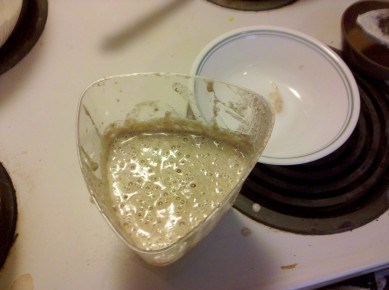In making a sourdough starter, we go hunting for some rarer specimens of the yeast family than the usual sacchromyces cerevisiae that one will find dried at the supermarket. I don’t know specifically what yeast live here in Ohio, but I’ve managed to catch a handful and grow them atop my fridge. I started, in a bit of silliness, using some spring water gathered from a favored hiking spot of mine, the sulfur and iron-rich spring in Glen Helen which gives the town of Yellow Springs, OH its name. I took with me an empty milk jug, filled it to the brim, and returned home.
Though I wasn’t planning on it at the time, this proved to be a great choice, though less for the water of Yellow Springs than for the milk jug. A sourdough starter is not actually so simple as your standard storebought freeze-dried automagic yeast. You will never find one that just consists of a homogeneous bunch of yeast, all born from the same batch of a single species. Rather, it is a living and breathing ecosystem, built not just of yeast, but of other organisms, including crucially lactic-acid producing bacteria that thrive on lactose. This acid gives the sourdough its characteristic flavor, and furthermore creates an environment that is comfortable for yeast, but too acidic for many less desirable organisms like E. Coli and Salmonella. So storing the first water I used to make the starter provided an excellent source of sourdough-friendly bacteria to get things off to a good start.
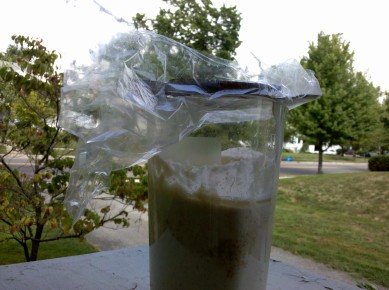
Loosely following a couple of guides I read on the web, I mixed a couple tablespoons of the water with a couple tablespoons of flour and left it to set overnight. The next day it didn’t look particularly active, so I added 1/2 cup flour and 1/2 cup of my now sour-smelling water to see if it would get off the ground. The next day, it definitely had begun to bubble a bit and take on the smell of something like sour yogurt. Generally speaking, the recipe for starter is very simple: combine equal amounts flour and water, and whenever you feed the starter additional flour and water, be sure to add enough to double the starter in size.


So, by Tuesday, to avoid overflowing the container, I was dumping out half of the starter each day, and feeding it half a cup of whole wheat flour, half a cup of unbleached white flour, and a cup of filtered water. By Thursday, it was beginning to smell properly yeast-like, and each day when it came time to feed it a quarter-inch layer of hooch had pooled on top. I wasn’t entirely sure if it had just separated, but after a little more time with it, I’m now sure that that layer of liquid is the mostly alcoholic dredge that rises to the surface after a day of yeasty fermentation. 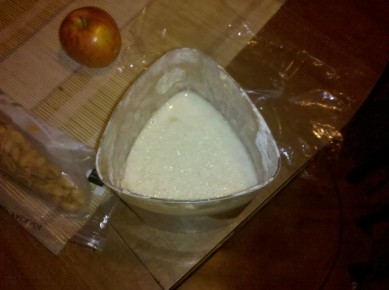

Friday evening I took a partially spur-of-the-moment trip to Ann Arbor for a Lindy Hop Exchange, and asked my parents to watch the starter and feed it on Saturday. Unfortunately, I neglected to write down specific instructions, and my father misremembered my “equal parts flour and water” as “equal parts flour and sugar.” When I took a look at it, it seemed a little dormant, but I decided to press on, dumped out half of it, and added enough water and flour to bring it back up to size.
This may have been a poor decision.
The next day, it had overflowed its container. Unfortunately, I don’t have any pictures of this, as my thought process was a little more along the lines of “Oh shit oh shit oh shit oh shit” than “Hey, this is an interesting example of what happens when you feed a starter way more sugar than you should ever feed a starter.” And I mean way more. I think I’d have to make four loaves of very sweet bread to justify adding a cup of sugar to a starter, and I’d only do it when I’m proofing the dough. Before I fed it, it smelled roughly like vomit.
So, I dumped out half of it, and fed it again. This may also have been a poor decision, but only because the next day it again overflowed its container leaving a trail of doughy sugary mess down the side of the fridge it had been growing on. At this point, it smelled pretty much like rum, with a hint of yeast, which I took as validation that though I had twice made some significant messes, my culture was quite safe, and generally enjoying the massive supply of simple sugars.
However, from now on I’m leaving at least enough room in my starter containers that the starter can double, and putting down a tray in case it still manages to go on a binge and overflow. Though just sticking to a steady diet of wheat and water would probably do pretty well for controlling it as well.
On Wednesday, it was smelling properly yeasty again, so I dumped some of it into a bowl with a fresh cup of flour and water, and left it to proof. However, I drained some of the hooch so I could get a sense for how sour it was going to be. This turned out to make, at the end, a couple of very familiar loaves of bread. (As it should have, since I’ve used this recipe many times.) 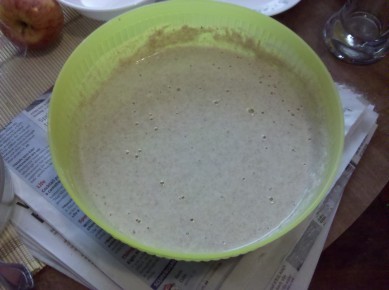
It’s far from scientific, and I’d hesitate to suggest you try to duplicate it precisely, since these things can be very fickle. Roughly, what I used was:
3 cups starter
2 cups whole wheat flour
1 cup white flour
1/4 cup sugar
3 tsp salt
2 T olive oilBut I should warn you I only really measured the flour, so those are fairly approximate. To begin, mix the sugar, salt, olive oil, and starter, and gradually add the rest of the flour.
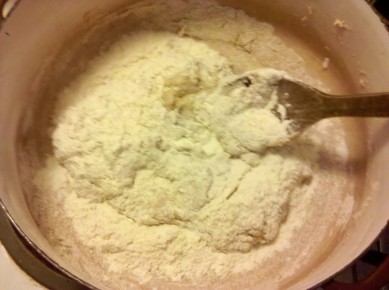
Ambient conditions will make the amount of flour fairly variable. This is something you can only really figure out with practice. Form the dough into a ball, and knead it until it begins to be round and smooth.

Use a little more olive oil to coat the ball of dough, cover it with a towel and let it rise until doubled in size. My starter rose in about an hour and a half with the wonderfully oppressive afternoon and evening heat we’ve been having lately. Once the dough has risen, knead it a bit more, break the dough into two loaves, and place them on two oiled baking stones. Let rise for at least another hour.
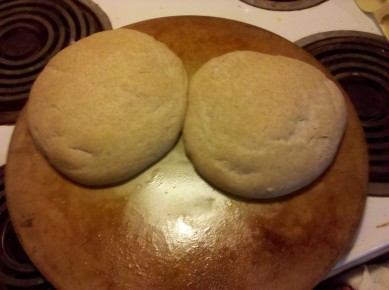
Bake for 55 minutes at 350 degrees, and you should have something that looks rather like this:
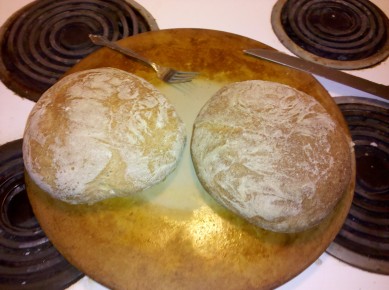
This is a familiar recipe I’ve used many times with storebought yeast, and it seems that it also serves my starter fairly well. After I was done I took some of the proofed starter, fed it with some leftover flour, and set it to wait for tomorrow. I’ve got a few other ideas I want to test out…
